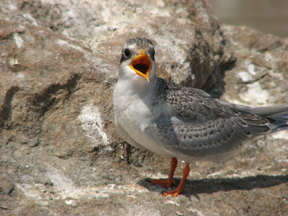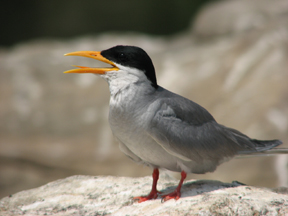River Tern. (Sterna aurantia)
-RagooRao
This month I introduce the River Tern to our readers. I was in Ranganthittu bird sanctuary a fortnight back and I could get some good pictures of a lot of migratory
birds which come there for nesting. Ranganthittu is a very beautiful and well preserved bird sanctuary nestled deep in the islands of Kaveri river. I have uploaded a trip report to this sanctuary on the “ Bird Sanctuaries” page, at the link
http://www.indianwildlifeclub.com/UserContent/Trip-Report-Details.aspx?rid=536
Now, back to our bird of the month.
 A slender, graceful white bird about the size of a pigeon, with grey upperparts and a black cap on the head, with yellow beak flying gracefully on rivers is the
River Tern. The tail is long and deeply forked and both sexes look alike. The birds take a deep glossy black head and nape in the summer months, being the breeding season.
A slender, graceful white bird about the size of a pigeon, with grey upperparts and a black cap on the head, with yellow beak flying gracefully on rivers is the
River Tern. The tail is long and deeply forked and both sexes look alike. The birds take a deep glossy black head and nape in the summer months, being the breeding season.
These birds are very graceful fliers and they frequently land on rocks in the river with a fish firmly held in their beaks. The legs are short, yellow colored and stubby.
The juveniles will not have their black markings but have grey and speckled upper parts.
Distribution is throughout the country and another inland Tern of Indian waters is black bellied and the Gullbilled tern is found occurs on the sea coasts.
It is really a sight to watch these birds fly just above the river waters with graceful flapping of their wings scanning the waters for fish. When they find one they
dive into the water with closed wings and scoop up the fish firmly held in their bills. This is when they alight on a rock in the river and gulp the fish. Soon the ritual is resumed once again. Fish being their mainstay they also relish crustaceans, tadpoles
and water beetles.
The breeding season is in the summer months sometime during March to May. They only scout for a nesting site, sometimes in colonies of terns but do not build any kind
of a neat. 
2-3 greenish grey eggs blotched and streaked with brown and sometimes purple streaks are also found, which are laid on plain ground among rocks and sand banks in the
rivers. Whether both the sexes share all domestic chores is to be confirmed, as observing this behavior is a little tricky with both the sexes looking alike and there being a colony of birds.
A very graceful bird and a marvelous sight to see while skimming across the waters is very silent during flight. Right now there is no threat to their survival but as
we keep polluting the rivers, which affects the aquatic life, there could be chain reaction and their survival may be threatened.
(Text and Photographs RagooRao)